Managing annual ryegrass in cropping systems - pre and post emergent herbicide trial, Barellan 2013
Author: Barry Haskins and Angus MacLennan | Date: 12 Mar 2014
Barry Haskins1 and Angus MacLennan2,
1Ag Grow; 2Bayer CropScience
Take home messages
- Annual ryegrass is a major limitation to productive cropping systems and as herbicide resistance levels increase, this is only going to get worse.
- Pre-emergent herbicides provided greater than 95% control of annual ryegrass in this demonstration trial.
- There was a definite difference in the level of control recorded between pre-emergent herbicides tested.
- Post emergent herbicides provided little or no control of ryegrass, with the exception of Atlantis and to a lesser extent Boxer Gold (which is currently not registered for this purpose).
- Burning stubble decreased the efficacy of all pre-emergent herbicides and accelerated crop maturity.
Background
Annual ryegrass has become a major constraint to productive and profitable cropping systems over the past three to five years. This has been accelerated as a result of ineffective weed control; caused possibly by poor post emergent herbicide options, and therefore, development of herbicide resistance.
Cropping intensity has also played a role, as crop rotations have tightened and leaned more towards no-till farming systems, which rely heavily on herbicides for weed control.
The importance of pre-emergent herbicides has therefore increased, along with the necessity to undertake agronomic strategies to maximise pre-emergent herbicide effectiveness.
Trial details
A trial was established at Barellan, in conjunction with Bayer Crop Science, aimed at evaluating a range of pre and post emergent herbicide options applied in both a stubble retained and stubble burnt no-till system. Across the treatments, a number of post emergent herbicides were applied as a matrix (Figure 1).
There were seven pre-emergent treatments used in this trial including untreated, Sakura®, Sakura® plus Avadex® Xtra, Sakura® plus Logran®, Boxer Gold®, TriflurX® and TriflurX® plus Avadex® Xtra. There were also six post-emergent treatments including Boxer Gold®, Atlantis®, Decision®, Topik®, Axial® and Achieve®.

Figure 1. Trial plan.
The paddock chosen has a high history of annual ryegrass, however control over the past two years was deemed adequate. The paddock was sown to wheat in 2013, wheat in 2012 (had Sakura® applied pre-emergent) and canola in 2011.
Rainfall in 2013 was variable during the year. There was average fallow rainfall providing approximately 60cm of subsoil moisture. Soil conditions were moist prior to sowing, and remained moist during early crop growth. Conditions then dried into Spring. Growing season rainfall was 220.5mm (Table 1)
Table 1. 2013 rainfall (January – October)
| Month | Jan | Feb | Mar | Apr | May | Jun | Jul | Aug | Sept | Oct |
|---|---|---|---|---|---|---|---|---|---|---|
| 2013 Rainfall (mm) | 0 | 40 | 15 | 2.5 | 40.5 | 59 | 33.5 | 19.5 | 57 | 8.5 |
The stubble was burnt (in the burnt treatment) on 17 April under warm conditions. The burn was quick and hot (Figure 2 and 3). The stubble load in this trial was estimated at 5t/ha (Figure 11). Pre-emergent herbicide treatments were applied 6 hours prior to sowing SpitfireA wheat on 20th May. The seeder used was a Gason knife point and press wheel seeder on 33cm row spacings using an inverted T McCoy point.
Post emergent herbicide treatments were applied on 6th July when wheat was one to two tiller and ryegrass three to five leaf/early tiller. Herbicides were applied with 80L/ha water, using flat fan 11002 nozzles creating a fine/medium droplet pattern.
Calendar of operations
|
17th April. |
Trial established and stubble burnt (warm burn). Conditions were dry and 26deg C. |
|
20th May. |
Pre-emergent herbicides applied 1-3pm. Paddock sown to SpitfireA at 35kg/ha on 33cm row spacings with 80kg/ha of MAP/SOA blend. |
|
13th June. |
Establishment counts taken. |
|
6th July. |
Applied post emergent herbicide treatments. |
|
23rd August. |
Weed control scores taken. |
|
16th October. |
Final weed control scores and panicle counts taken. |
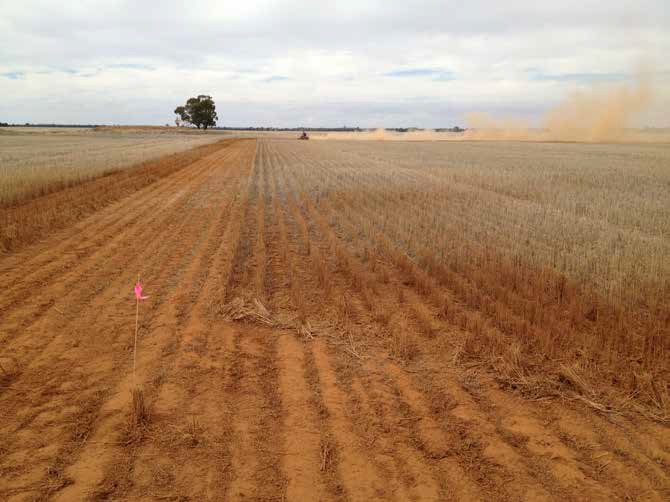
Figure 2. Picture of the trial being prepared for burning. Edges were mown to minimise the
chances of the fire escaping.
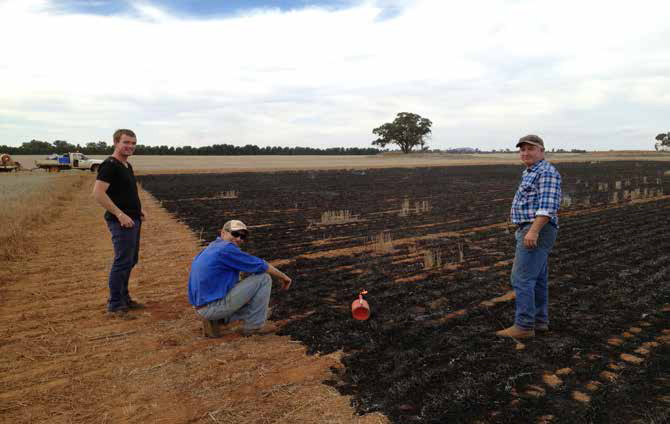
Figure 3. Picture of the stubble just after burning.
Results
Establishment counts and weed counts were performed on 13th June (Figure 4 and 5). Weed control scores (following post emergent application) were performed on 23rd August. Final weed control scores were taken at crop maturity on 16th October (Figure 8).

Figure 4. Wheat establishment counts taken on 13th June (average of four counts in plants/m2).
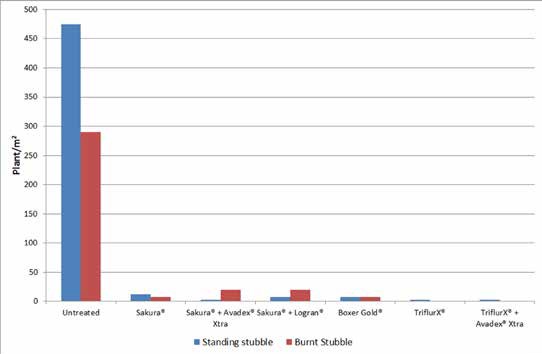
Figure 5. Ryegrass counts taken on 13th June (average of four counts in plants/m2)
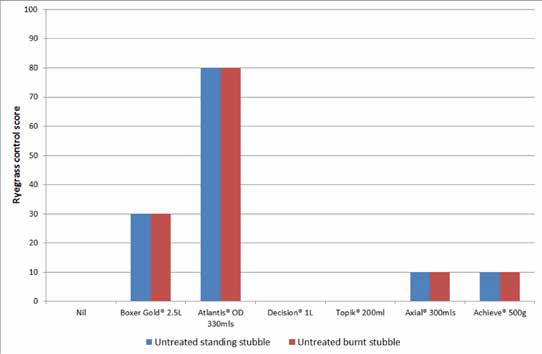
Figure 6. Ryegrass control scores in nil pre-emergent treatment (0 no control - 100 full control) taken on 13th June (subjective scores based on visual assessment).
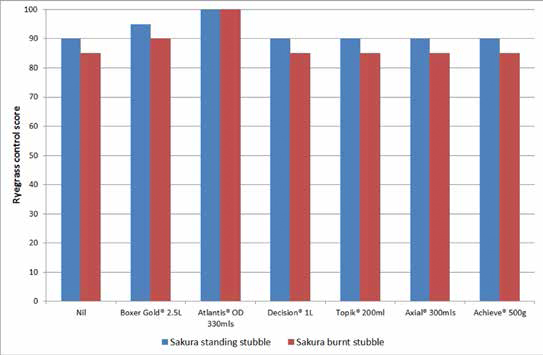
(a)

(b)
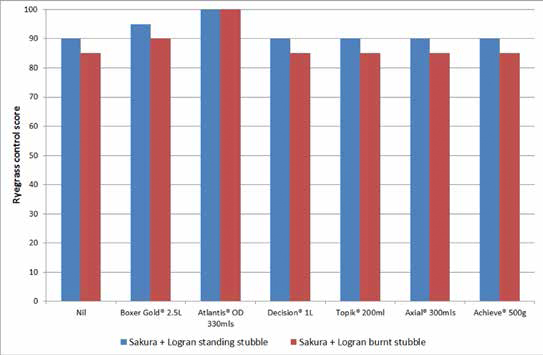
(c)
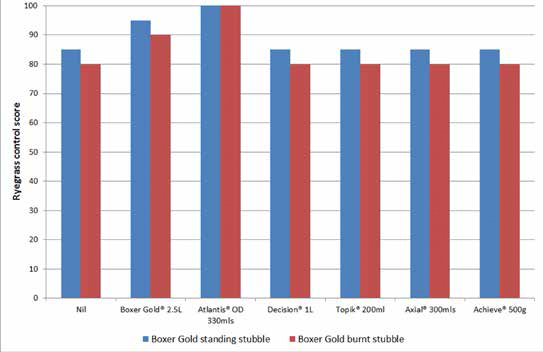
(d)
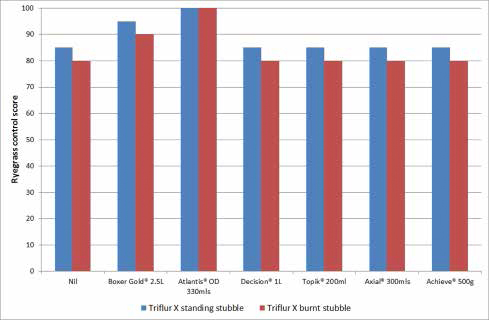
(e)
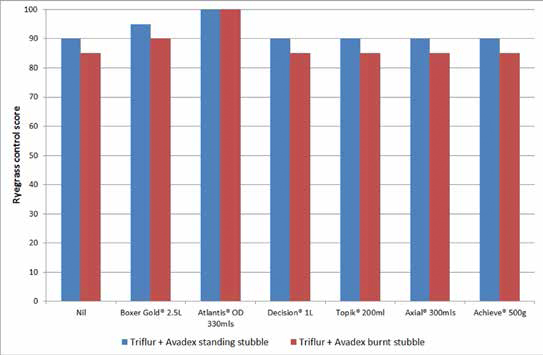
(f)
Figure 7(a-f). Ryegrass control scores in each pre emeregent treatment (0 no control - 100 full control) taken on 13th June (subjective scores based on visual assessment).
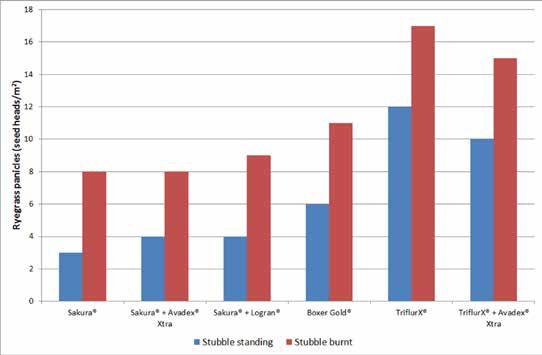
Figure 8. Final ryegrass panicle counts taken at crop maturity on 16th October. Counts are ryegrass panicles (see heads/m2) with no post emergent treatment following
Discussion
Effect of pre-emergent herbicides on ryegrass
All pre-emergent herbicides performed extremely well and provided excellent weed control over the nil control. In most cases greater than 98% control of ryegrass was achieved when the first counts were performed in June.
As the season progressed, the residual effect of some of the herbicides was reduced. This in turn reduced the average weed control across all pre-emergent herbicides to 95.5% of the nil control.
There was a difference in the level of ryegrass control between the pre-emergent herbicides.
All products were very hard to differentiate in their control of ryegrass in the inter row, however within the plant row measurable differences were able to be identified.
Sakura® and Sakura® mixtures provided the highest level of control, followed by Boxer Gold® and then Trifluralin and Trifluralin mixtures (Figure 9 and 10).
This is most likely the result of varying residual activity between products, and their ability to wash into and provide weed control within the plant row.
Effect of stubble on pre-emergent herbicides
The presence of stubble increased the weed control achieved with pre-emergent herbicides. This result was unexpected, but consistent across the trial.
The reasons for this are not definite, however would likely be due to the effect that stubble may have had on surface soil moisture, where retained stubble showed wetter surface soil moisture than where the stubble was burnt. This wetter surface soil moisture may have resulted in the pre-emergent herbicides being active for a longer period of time and also more consistently during early crop growth when the ryegrass was germinating. Stubble is also known to reduce weed establishment, and this may have played a small role.
Interestingly, where the stubble was retained the crop was noticeably greener in October. This may be due to the nutrient value of the stubble becoming available at the end of the season.
Effect of post emergent herbicides on ryegrass
Post emergent herbicides were applied across the trial as a matrix at the perfect weed and crop growth stage and received favourable environmental conditions prior to and following application.
Unfortunately, this site highlighted the level of resistance to the post emergent herbicides, with only Atlantis providing a satisfactory level of control.
Boxer Gold (not registered for this purpose) only provided 30% control when used as a post emergent, and also caused slight crop damage.
The remaining herbicides provided little or no control, and would have been a waste of money in a commercial situation.
Summary
This trial has highlighted the value of pre-emergent herbicides in no-till farming systems, especially in the presence of stubble.
It does however highlight the fact that under high pressure situations, even the best pre-emergent herbicides do not provide 100% control, which unfortunately allows seed set for the following season.
In this trial, full control was only achieved by applying a pre-emergent herbicide in conjunction with a post emergent herbicide that had no resistance. In this case Atlantis was the product of choice. Unfortunately in a commercial situation the cost of this practice is often difficult to justify.
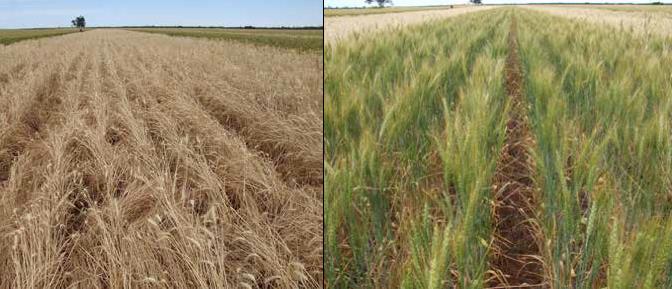
Figure 9. The ryegrass observed in the untreated control (left) compared to Sakura (right). The
control was sprayed with two litres of Roundup three weeks prior to this photo aiming to minimise seed set.
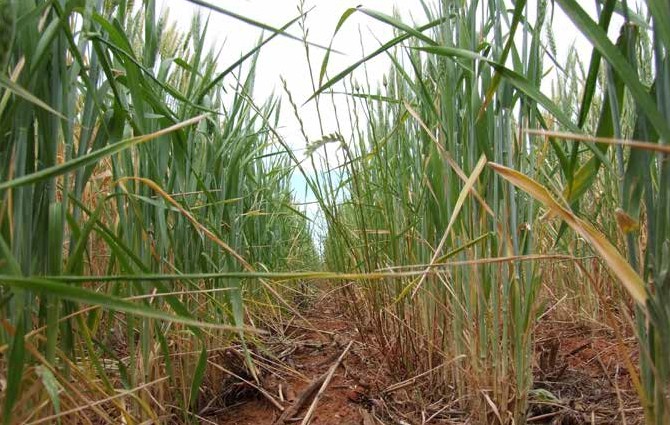
Figure 10. Ryegrass growing in the plant row in the Trifluralin treatments.
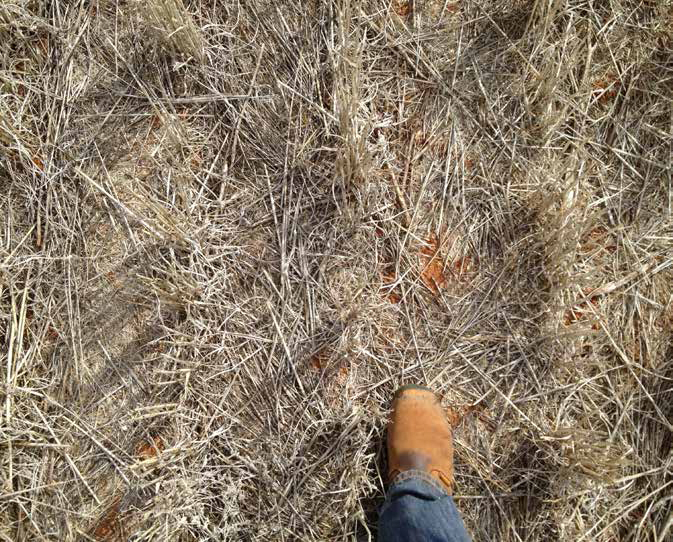
Figure 11. Stubble load of the paddock prior to sowing. This stubble load was estimated at 5t/ha.
Acknowledgements
This trial was a collaboration between Ag Grow Agronomy and Research and Bayer Crop Science. Ag Grow would like to formally thank Angus MacLennan (Bayer) for his technical expertise in trial design and analysis. Trial co-operators Leo and Jeff Savage provided significant time in hosting the trial, and also aided in various activities in the trial, and for this we are grateful.
Contact details
Barry Haskins
Angus Maclennan
Was this page helpful?
YOUR FEEDBACK
